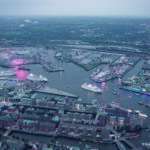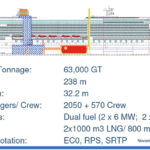Heinrich Reincke,
Meike Hildebrandt
1. Introduction
International shipping is responsible for 2.7 % of the global emissions[ds_preview] of carbon dioxide (CO2) and it is considered to be the most energy efficient mode of transportation [1]. Nevertheless, it constitutes an extensive burden for the environment and human health close to shore because ships produce not only CO2 but also huge quantities of sulfur oxides (SOx), nitrogen oxides (NOx) and particulate matter (PM).
This is a special problem with cruise ships, because cruise terminals tend to be close to residential areas (for example in direct neighborhood to the HafenCity in Hamburg). Additionally, due to the so-called »hotel load«, cruise ships use more energy at berth than normal ships do, because this load has to remain equal of many or only few persons on board during the laytime. Energy is produced by means of mainly Diesel engines (propulsion and electricity) and the auxiliary boiler (for hot water and steam) and the emissions are accordingly high. The hotel load is responsible for the bulk of the total emission of a cruise ship in the port; the share produced while moving into and out of the port and maneuvering the ship is comparatively lower [2]. On the other side, there are great economic benefits from cruise tourism in many areas. These particularities have lead to considerations of different measures for reducing emissions from cruise ships in the port.
2. Air pollution
2.1. Pollutants
SOx can lead to damages to human health (irritation of the respiratory system and increase of cardiovascular diseases) and damages to the environment (acidification of soil and water). The amount of SOx in the exhaust fumes depends on the sulfur content of the fuel, which can be reduced by expensive and energy intensive methods. German gas stations offer fuel with a sulfur content of 10 ppm (<0.001 %) or less for land vehicles, while ship fuel is still much less regulated, even though within the last years there have been international efforts towards that goal. Due to this, the share of shipping caused sulfur emissions in ports is very high.
NOx can cause cell mutations and cancer. In addition, it can cause ground-level ozone and asthmatic reactions. Environmentally, NOx is responsible for over-fertilization of soil and water; it can become acid rain, increase the climate change and play an important role in the generation of smog.
The possible consequences of particulate matter are a reduction of the lung function of children and young adults, lung cancer, cardiovascular diseases and a general increase of the mortality rate of 4–8 % per 10 g/m³ particulate matter in the air. It can also cause artificial clouding. The emission of particulate matter seems to be related with the sulfur content of the fuel, therefore a stricter regulation of the sulfur content may lead to less particulate matter in addition to less SOx emissions [3]. CO2 has no effects on the local air quality but as a greenhouse gas it increases global warming.
2.2. Regulation
MARPOL 73/78 Annex VI regulates the globally binding environmental agreement of the International Maritime Organization (IMO) concerning air pollution by ships.
Currently, the sulfur content in shipping fuel is limited to 4.5 %, while in the specially designated SECAs (SOx emission control areas) and ECAs (emission control areas), which include the North Sea and the Baltic Sea, it is limited to 1 %. These limits will further decline within the next years.
There are three levels in the regulations of NOx (Tier I-III), starting in the years 2000, 2011 and 2016, respectively (Fig. 1). The NOx emissions are limited depending on the rated engine speed. Tier I sets a limit of 17.0 g/kWh for a rated engine speed lower than 130 rpm and of 9.8 g/kWh for a rated engine speed above 200 rmp. The limit between 130 rpm and 2000 rpm is calculated with a mathematical formula (NOx emission limit = 45 · n-0.2, n = rated engine speed). Tier II is a reduction of 20 % and Tier III a further reduction of 80 % based on Tier I, but both levels only apply for ships built or re-equipped with new machines after the commencement of the regulation. Furthermore, Tier III is only applicable in ECAs.
For SOx, the EU directive 2005/33/EG applies in addition to the MARPOL regulation. For ships in ports it stipulates a fuel sulfur content of 0.1 % or the use of shore-side energy supply. This directive has already been implemented in Hamburg. NOx emissions are not covered in the directive and therefore would only decrease if shore-side energy supply is chosen over sulfur reduced fuel.
3. Situation in Hamburg
In 2010, Hamburg’s two cruise terminals will receive about 100 calls from cruise ships (Fig. 2). It is a very small percentage of all activities in the port but the cruise terminals are close to residential areas whose inhabitants are directly affected by cruise ship emissions. The cruise season is from April to September, with ¾ of all calls falling between June and August. [5] Tourists from the cruise ships are most welcome guests to the city, but cruise ship emissions pollute the air, especially in the HafenCity.
The current coalition agreement between the conservative party CDU and the Green Party includes a binding climate protection goal of a 40 % reduction of CO2 emissions till 2020. In addition, it proposes a port-cooperation in Northern Germany with common environmental standards, which could include a concept for shore-side power supply. [6]
There is a petition of the city’s parliament about shore-side power supply. The parliament asks the government of Hamburg to research possibilities for environmentally friendly energy supply for ships, to develop a concept for the energy supply of the cruise terminals, to initiate pilot projects and to advocate common international standards.
The discussion group »Reduction of emissions from cruise ships« was founded in 2008, in order to research options for the two cruise terminals. Participants include representatives from the concerned administrative bodies, and experts from the industry. The discussion group met seven times up to now and examined and discussed various aspects and possibilities, including technical and regulatory developments during the last two years, with various experts from energy suppliers, European cruise associations and the European Commission.
Individual solutions in particular ports seem unfeasible because cruise ships call at many ports on their journeys. Therefore, Hamburg started an initiative in 2008 to establish an »Alliance of European cruise cities supporting environmentally friendly power supplies for cruise liners«. Other cruise cities in Germany (Bremen, Kiel, Lübeck and Rostock) supported the initiative. In the next step, Hamburg approached European cruise cities and promoted the alliance. Around 20 cities expressed their interest in the alliance. MedCruise, an organization of cruise cities of the Mediterranean Sea and the Black Sea, is also interested in the discussion in Hamburg.
4. Technical possibilities
The discussion about measures to reduce ship emissions focused on two possibilities: shore-side power supply and gas as ship fuel.
4.1. Shore-side energy supply
Modern cruise ships usually have medium-high-voltage systems with a line voltage of 11,000 or 6,600 V and a frequency of 60 or 50 Hz. Older and smaller cruise ships can have low voltage systems with 440 V / 60 Hz or 400 V / 50 Hz. German land power systems are medium-high-voltage systems with 10,000 V and 50 Hz.
A typical onshore power supply system (Fig. 3) includes (1) a connection to the national land power system via a local transformer station, (2) power cables to connect to transformer and converter station with the terminal, (3) a converter to adjust the frequency (50 Hz to 60 Hz), (4) power cables to the terminal, (5) a technical system to handle the cables, (6) a plug connection on board of the ship and eventually (7) a transformer on board for the transformation to 440 / 400 V (if the ships has a low voltage system).
Special demands for onshore power supply systems include the necessity to convert the frequency from 50 Hz to 60 Hz, the required capacity (the »Queen Mary 2« has an energy requirement of up to 12 MW while »normally« sized cruise ships require 5–7 MW, which is similar to the energy demand of a small town with 40,000 inhabitants), and the fact that the energy demand is not steady over time. In addition, there are legal liabilities and safety-related issues because of the interface.
At first, the simple idea to bring ecological energy on board via a cable and shut down the engines seems convincing. There are few ports worldwide with onshore power supply systems (including Los Angeles, Seattle, Juneau and Lübeck), but from a technical perspective it is possible and all emerging problems can be solved with significant effort.
However, the idea requires further examination. To begin with, ships are designed to produce the energy they consume themselves. They are not equipped with a power socket suitable to supply the whole ship with onshore power. There is a power socket for the shipyards but this can supply only a small part of the energy needed in the ship’s load. Every single ship would need to undergo complicated and expensive reconstruction work before it could take onshore energy. Therefore, onshore energy supply is better suited for ferries or regular line haul ships, which call at the same ports again and again, not for cruise ships, which call at many different ports. The two cruise terminals of Hamburg received 25 different cruise ships with 25 different board installations in 2010.
Furthermore, the use of onshore power does not equal zero emissions. The supply of onshore power is not equally sensible for all parts of the ship’s energy demand. For example, the auxiliary boiler (responsible for hot water and steam) would have to remain in use, so that the engines cannot be turned off completely. Onshore power can be produced with much fewer emissions than the power produced by the ship engines (depending on the technology and procedure), but they do cause emissions, too, and due to higher losses from transport and friction, the energy efficiency of onshore power is not as favorable as it could be, the total energy balance is bad.
The biggest obstacles for the use of onshore power are the costs. Onshore power is in itself more expensive than power produced on board. Additionally, there are millions of Euros in investments for the supply system on the land side which need to be refinanced through the electricity price, and investments of up to several hundred thousand Euros on the ship side per ship. Onshore power will therefore be several times as expensive as power produced on board. Even broken down to the individual passengers, these figures constitute a severe distortion of competition for ports and ship owners who supply and use onshore power. Hence, individual efforts towards onshore power can hardly by economical.
4.2. Gas
Gas as a ship fuel is still heavily restricted due to safety reasons, but currently there are many technical developments and projects in this area. For example, the shipping company Stefan Patjens GmbH & Co. KG plans a gas installation on board of a 5,000 TEU container ship in 2012 [8]. Also, there are concept studies for passenger ships in progress (Fig. 4), e.g. GasPax. Gas fueled ships seem to be technically possible and economically reasonable. In June 2009, the IMO introduced an interim guideline for gas fueled ships while a legally binding code is worked on and should come into effect with the SOLAS revision in 2014. [9]
Gas has an enormous potential to avoid air pollution. Natural gas has up to25 % less CO2 emission, 100 % less SOx emissions, 80–90 % less NOx emissions and 100 % less particulate matter emissions than Marine Diesel Oil (MDO) [11]. A ship would produce fewer emissions during the whole journey and not only during calls at ports with onshore power supply systems. On the other hand, the usage of gas as a fuel leads to methane emissions, which influence the greenhouse effect. An oxidation catalyst could help with this problem; for ships, it is currently under development [12].
A possible solution for the use of gas as fuel for ships could be a so-called dual-fuel motor which can be fueled with gas as well as normal fuel. Gas could be used while the ship is in ports or in SECAs / ECAs, outside these areas the ship would use normal fuel. Another idea is to reconstruct ships so they can use shore-side gas while in the port. The natural gas supply system in Europe is still in development and could not yet cope with the demand of a higher number of purely gas-fueled ships anyway.
If gas can be established as a shipping fuel, the expected reduction of air pollution will take years. The necessary reconstruction of the engines is possible but much more extensive than the changes necessary for onshore electricity, which means more time and money. The lifespan of a ship lasts several decades; therefore, replacements for the currently used fleet will not happen fast.
4.3. Comparison of onshore electricity and gas
Both gas and onshore electricity are technically viable options and both would reduce the emissions from cruise ships in ports. Neither is an ideal solution. An onshore power supply system could be realized relatively fast and the necessary reconstruction on board is less extensive than replacing the engine with a dual-fuel motor. On the other hand, there are high costs to pay for the harmonization of the different electrical systems on every ship. Emissions in the port would not be avoided entirely, because the auxiliary engine would still be needed. Emissions from the production of shore-side electricity would need to be carefully examined. A survey of the European Commission showed onshore power to be worthwhile in some European ports because of the avoided costs due to health impairments, but other methods of reducing emissions are still more effective in relation to the initial investments. In addition, there are doubts whether ship owners would actually be willing to use the expensive onshore electricity.
Gas as a shipping fuel is still in the experimental stage. If it is found viable and economically worthwhile, it will still take a long time for the majority of ships to use gas, because of the longevity of ships. Reconstruction work on existing ships for the usage of gas as a fuel is extensive and expensive. The supply net for gas is still in development and the handling of gas requires severe safety precautions. Furthermore, gas leads to a reduction of CO2, SOx, NOx and PM, but it causes methane emissions. However, the total energy efficiency of gas as a ship fuel is still better than that of onshore electricity, because there is no loss due to transfer and transformation. A clear advantage of gas is the potential to reduce emissions not only in the port but during the whole trip.
5. Conclusion
The reduction of the sulfur content in shipping fuel to 0,1 % in ports of the European Union is in effect in Hamburg already and it plays its part in the reduction of emissions of cruise ships in the port. It is important to implement the EU directive in all member states as fast as possible and to control the compliance. In addition, the Mediterranean Sea should be handled similarly to the North Sea and the Baltic Sea and be declared a SECA (later an ECA), in order to increase the speed of emission reductions. Improvements can be achieved faster on a level playing field with equal conditions. To work towards equal conditions is a political assignment.
Onshore electricity is a possible solution for the reduction of only the local emission, but its implementation depends on the price the stakeholders are willing to pay. Currently, there is a notable reluctance of ship owners to invest in the necessary reconstructions and to pay for expensive onshore electricity when they can produce it cheaper themselves. In addition, about 30 % of the energy demand of a cruise ship cannot be met by onshore electricity and has to be produced on board. The industry seems to be concentrating on gas at present; first on dual-fuel engines and later (starting around 2025) on totally gas fueled ships. Some older ships might undergo the necessary reconstruction for gas or as an alternative could be re-equipped with exhaust gas filter systems like scrubbers, catalysts, etc. to reduce emissions. This area, too, has technical challenges and innovative approaches for solutions.
Energy efficiency is not only an environmental goal, but a self-serving interest of the shipping industry, because it reduces operating costs. A ship which emits neither CO2, which is harmful for the climate, nor NOx, SOx and PM, which are hazardous for human health and the local environment, cannot be expected for the foreseeable future but the regulatory and technical development are clearly progressing in the direction of the reduction of emissions.
Prof. Dr. Heinrich Reincke,






















